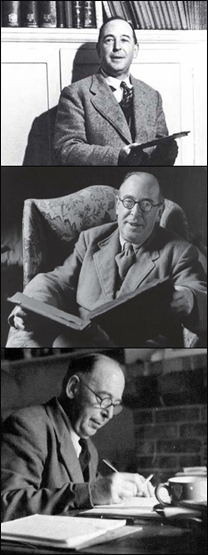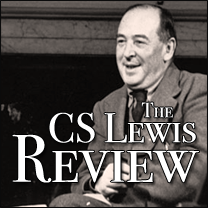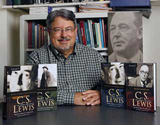
The Lion, the Witch, and the Wardrobe Resources
The Chronicles of Narnia: The Lion, the Witch, and the Wardrobe
(Copyright 2010-11 by Bruce L. Edwards. Click here for Permissions information)
[To schedule a presentation or seminar on Narnia, contact me here]
Reading Comprehension Questions
- What are the circumstances that cause the Pevensie children to end up in Professor Kirke’s household? What is their initial reaction to being so far from home and their parents?
- Think about the setting as you encounter Narnia for the first time. Who is in control in Narnia when Lucy first visits through the Wardrobe? Why is it “always Winter and never Christmas”? How is this symbolic of what is happening to the creatures who inhabit Narnia?
- Think about the respective character development of Lucy and Edmund. Compare and contrast the differing reactions Edmund and Lucy have in their first trip into Narnia. How do you account for their different allegiances and behaviors?
- When Peter and Susan bring Lucy’s “odd behavior” to Professor Kirke, how does he respond? What are the Professor’s three options for explaining Lucy’s behavior and how does he lead Peter and Susan to the “logical” conclusion?
- Why are the children referred to as the “sons of Adam and daughters of Eve” by the inhabitants of Narnia? Why does their presence evoke such apprehension in the White Witch?
- What kinds of characteristics are attributed to Aslan by Mr. and Mrs. Beaver before he arrives on the scene in person? What anticipation do these descriptions create in the children? When he does arrive, what effect does his presence have?
- Explore the “logic” at work in Professor Kirke’s interview with Peter and Susan about Lucy’s alleged trip to Narnia. Why does he focus on three alternatives? Why do Peter and Susan find these options so distressing?
- Reflect on Mr. Beaver’s comment that Aslan “is not safe, but he is good.” What are the implications of this for the children and their evolving knowledge of what to expect in Narnia? What expectations does it create for you?
- To justify her planned execution of Edmund, the White Witch cites the “Deep Magic from the Dawn of Time.” What is the nature of this “deep magic”?
- Why is Aslan bound to obey the dictates of the “deep magic”? What would it mean for him to disobey “his own rules”?
- The themes of redemption and resurrection are strong in The Lion, the Witch, and the Wardrobe as Aslan triumphs over the Witch’s treachery and redeems Edmund as well as the rest of Narnia. Explain in your own words what the “Deeper Magic from Before the Dawn of Time” is, and its thematic parallels to the story of Christ in the Gospels.
- There are some obvious Christian parallels in The Lion, the Witch, and Wardrobe, including Aslan’s sacrificial death on behalf of Edmund and his resurrection from the dead. What are some other parallels at work in this first Chronicle?
Thematic Discussion Questions
- Imagine that you are each of the four Pevensie children. What would their journals look like after their first visit into Narnia? Write several entries on behalf of each of the children.
- Is there a personal episode that is particularly dramatic in your spiritual life that is like “going through the Wardrobe”? Consider this event and then explain its relevance to your past spiritual awakening or spiritual challenge.
- Aslan is a formidable character and to many his “not safe, but good” qualities are unsettling. How do you find them? Does Aslan bring the same comfort to you that he seems to bring to Susan and Lucy? Why or why not?
Personal Reflection Questions
- What makes it easy or difficult to take the journey to Narnia? After you have been there, is there a temptation to stay, or do you want to come back and share your experiences?
- Professor Kirke in The Lion, the Witch, and the Wardrobe emphasizes logic in his dealings with the children, even though he is pointing to a supernatural reality that would presumably defy logic. Is it “logical” to believe in the supernatural? Reflect on this and share your views.
- Simply put, what is the “Turkish Delight” in your life? That is, what is most tempting to you to get you to veer off of your spiritual path to lesser goals and duties?
- With which of the Pevensie children do you identify the most? Why?
- Does the strong parallelism between Aslan and Christ strengthen or weaken the story?
What We Learn: Image, Character, Theme
Image
- The Wardrobe: this “ordinary” piece of furniture becomes extraordinary in the imagination of Lewis. It is Lewis’s way of suggesting the transcendent and eternal are close by, “just around the corner,” and that there are “portals” all about us that may be the “way in” to the sublime and the supernatural, if we have “eyes to see.”
- The Lamppost: the lamppost is a landmark—a familiar sign of civilization but also a marker of where Narnia begins and ends. It is a visual map to the “Way back.”
- Turkish Delight: This exotic sounding treat mesmerizes Edmund and allows the White Witch to control him. It captures the sensuous strangeness of Narnia and the temptation any alluring object may foster to entrap us.
- The Stone Table: an allusion to the Biblical site for sacrifice and the role of the “scapegoat,” an innocent animal chosen to “bear the sins” of another. Here it underscores Aslan’s willingness to die on behalf of another. Its shattering also evokes the power of life over death, as depicted in the rolling away of the stone in front of the tomb of Christ when he is raised from the dead in the New Testament Gospel of Matthew.
Character
- Aslan: “Aslan” is the Turkish word for “Lion.” Lewis, as a master philologist, or lover of words, was familiar with many ancient and classical languages.
- Professor Kirke: Lewis models this character on William Kirkpatrick, who appears in Lewis’s autobiography, Surprised by Joy, as an early tutor who teaches him rigorous logic and challenges his stereotypes. Kirke appears as an important character in The Magician’s Nephew.
- Mr. Tumnus. This character is a faun—and exemplifies Lewis’s love of many traditions and myths, in this case, Greek and Roman Mythology. Throughout the Narnian Chronicles, Lewis will employ character, image, and symbol from various mythologies in mix and match fashion.
- The Beavers: Mr. And Mrs. Beaver are the first set of “talking beasts” we meet, and represent one of the many links to Lewis’s childhood fascination with the possibility of conversing with animals and what insight they would share on our world.
- The White Witch: This character is a staple of most fairy tales: the evil witch who practices nefarious magic on those she seeks to control and conquer. In this tale, the witch is notable for her attempt to use Aslan’s knowledge against him—unsuccessfully.
- The Thaw. In Narnia, under the White Witch, “it is always Winter and never Christmas.” When Aslan is “on the move,” signaled not only by his presence but the coming of the Sons of Adam and Daughters of Eve, a thaw occurs, thus symbolizing the coming Spring of freedom and redemption.
Theme
- Grace: The New Testament theme of “grace” is at work in this tale. Grace means “unmerited favor or care.” In this case, Aslan’s willing sacrifice on behalf of Edmund not only rescues Edmund, but also brings Narnia back to its rightful order. Grace operates without strings and is a free gift of the one who bestows it. Edmund is not saved because he deserves it, but because Aslan wills it.
- Redemption: This concept, which has roots in the Bible, but also in many ancient traditions, focuses on the character’s transformation over the course of a story. In this case, Edmund’s character is both thematically and literally “redeemed.” He both grows and matures during his adventures, regretting his evil and embracing the good, and is also “redeemed” by Aslan’s sacrifice, making it possible for him to escape the consequences of his deeds.
- Resurrection: Lewis uses the New Testament story of Christ’s resurrection from the dead as the basis for Aslan’s return to life. The Emperor-Beyond-the-Sea brings his son, the Great Lion, back from the dead.
- Restoration: After the White Witch and her followers are defeated, order can be restored to Narnia and its rightful rulers established—in this case, Peter, Susan, Lucy, and Edmund. This is in fulfillment of the prophecy that two Sons of Adam and two daughters of Eve would reign in Narnia.



